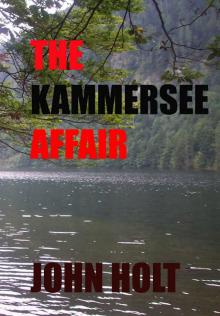The Kammersee Affair Read online
The Kammersee Affair
John Holt
Phoenix Publishing – Essex – UK
© October 2012 - John Holt
CONDITIONS OF SALE
John Holt has asserted his right under the Copyright, Designs and Patents Act 1998 to be identified as the author of this work.
All rights reserved. No part of this publication may be reproduced, stored in a retrieval system, or transmitted in any form or by any means, electronic, mechanical, photocopying, scanning, recording or otherwise, without the prior permission of the publisher, except by a reviewer who may quote brief passages in a review to be printed in a newspaper, magazine or journal.
This book has been sold subject to the condition that it shall not, by way of trade or otherwise, be lent, resold, hired out, or otherwise circulated without the publisher’s prior consent in any form of binding or cover other than that in which it is published and without a similar condition including this condition being imposed on the subsequent purchaser. All characters in this publication are fictitious and any resemblance to real persons, living or dead is purely coincidental.
British Library Cataloguing in Publication Data.
A CIP catalogue record for this book is available from the British Library
Printing History
First published by Raider Publishing International, New York, in December 2006
This second Edition has been re-edited and re-issued by Phoenix, Essex, UK, in October 2012
Preface
The story that follows is entirely fictitious. None of the characters portrayed ever existed, and, generally, none of the described actions ever took place. Although the towns mentioned in the story are actual places, street names are purely fictitious. Places within those towns – churches, police stations, shops, parks, railway stations, etc – are all, generally, imaginary.
The story was ignited by a visit I made to the area in August 2005. It was then subsequently fuelled by a short article, taken from the Internet, that described the events and activities in the Lake Toplitzsee area during the last few years of the Second World War, and during the subsequent post war years. As a consequence certain actual events do feature within the story, although not necessarily in the correct historical time period, or indeed, in the actual real life context. In short I have taken certain liberties with actual events, and manipulated them for my own purposes. I have also taken liberties with geographical features. Although they are real lakes, the geographical features around Toplitzsee and Kammersee, have been adapted, and added to, in this story, to suit my purpose.
The photograph on the cover is of Lake Toplitzee, and was taken by myself in August 2005.
My thanks go to Michael and Barbara Morton for their un-tiring work in checking the formatting of the manuscript.
I am grateful to Lauren Ridley, Cherryloco Jewellery for allowing me to base the Phoenix logo on her design
John Holt
Dedication
Dedicated to my wife Margaret
In memory of our holiday
In Grundlsee in the Austrian lake district
August 2005
Prologue
The lakes, which form the basis of this story, are situated in the Austrian Salzkammergut – the Lake District, in the District of Stiermarken. They lie approximately 150 kilometres to the south-southeast of Salzburg.
Lake Toplitzsee (shown on the front cover) is approximately 718 metres above sea level. It is approximately 1920 metres long and 388 metres wide, at its widest part. It is one of the deepest lakes in the region, extending down to a depth of 103 metres. Starting at a depth of about 20 metres, the water contains no oxygen. At that depth no organic life is possible. The water temperature of the lake is abnormal. Its basic temperature is about 5.8 degrees Centigrade, which is about 1.8 degrees Centigrade warmer than other lakes of this type. The name Toplitzsee probably comes from the Czech word “Teplice" which means "Warm spring."
Lake Kammersee is a much smaller lake. It is situated less than a half-mile to the east of Toplitzsee. The waters are much colder than Toplitzsee. It is also much shallower than Toplitzsee, being approximately half the depth. It is, however, still too deep for any underwater exploration, without the proper equipment. It is virtually inaccessible, although it is possible to get there by a small rowing boat, from Toplitzsee, through a narrow channel that had been cut by prisoners some one hundred years ago.
* * *
The story that follows is, in essence, fiction. However, for many years there have been many rumours circulating, relating to hidden treasures lying in Lake Toplitzsee. After the collapse of the Third Reich this speculation only increased. According to the eyewitness reports of dozens of local people, a number of crates were hidden in the Toplitzsee during the last days of the Second World War. Since then there has been repeated speculation that those crates contained the last gold reserves of the Third Reich. Over the years some amateur treasure hunters have paid with their lives for their carelessness, while exploring the lake, where diving is actually prohibited.
Professional divers have found large quantities of counterfeit British, and American, money in the lake during organized searches. Counterfeit stamps, explosives, weapons and other relics of that war have also been found. But gold itself has always remained an elusive prize. Even the existence of the gold has never been definitely confirmed. Nevertheless the legend continues, unabated, that there are crates of Nazi gold hidden deep in the Toplitzsee.
* * *
From about the middle of 1943, until the end of the war, the Nazis had established and operated a secret marine testing facility on Lake Toplitzsee. The facility had been set up to test dynamite, explosives, underwater torpedoes, mines and rockets. Using a primitive device, the scientists had even succeeded in launching a rocket from under the surface of the lake, a weapon that the United States perfected after the war with its submarine-based “Polaris” missiles.
As the end of the war in Europe drew to a close, orders were given that numerous items, including weapons, documents, and counterfeit money, were to be destroyed. There was a large amount of material, and limited time available before allied forces were due to arrive. Large quantities, of these items, were subsequently packed into wooden crates. They were then placed into the dark murky waters of the lake, and sent to the bottom, some 103 metres below the water’s surface. Whether or not plans existed for the recovery of these items at a later date is unknown.
It is known that several hundred documents were destroyed in this way. Torpedoes and crates of ammunition were disposed of in a similar manner. Large quantities of counterfeit money, and the printing presses that produced the forged notes, were also deposited into the lake. Apart from these items, there have been reports of quantities of jewellery, silver chalices, and gold trinkets being placed into the lake.
Rumours began to spread regarding buried treasures, and hidden gold bullion. Shortly after the Second World War, in 1946, two men had retrieved a wooden crate from the dark waters of the lake. It was said that the crate contained metal plates that had been used for printing counterfeit United States dollars. Subsequently, a number of other items were recovered from the lake. The rumours regarding Nazi gold continued to grow and grow. Each new discovery gave added weight to the rumours. Each new find encouraged further exploration, bringing with it additional risks.
* * *
In the summer of 1959 the German magazine “Der Stern” sent investigators to explore the lake. The divers recovered fifteen crates. All of the crates but one contained counterfeit British banknotes. Up until the end of the war, British pound notes were counterfeited and secretly brought into circulation in Saxony, under the code name, “Bernhard”. This code name referred to
Bernhard Krueger, the chief forger for Nazi Gestapo chief, Heinrich Himmler. The idea of forging English notes had come directly from Adolf Hitler himself. This forged currency was intended to weaken the British economy. At least ten more crates were known to exist, and were stuck in the mud too deep to be brought up.
In an exclusive interview, Krueger explained how they had carried out the most perfect money forgery in history, cracking the code of the Bank of England, and obtaining watermarks and the right paper. Most of the workers producing the forged notes were Jewish who knew they would be killed eventually to keep the forgery operation secret. The end of the war saved many of them from certain death. Also discovered were piles of secret documents, including orders for Hitler’s Schutzstaffel, (the SS, Hitler’s Protection Squadron). They even found a printing press used in a Nazi counterfeiting operation.
* * *
In order to finally put an end to the illegal treasure hunting and an end to the myth of gold in the lake, the Austrian Ministry of the Interior took action. In 1963, over 300 gendarmes closed off the Toplitzsee area and started a large mountain expedition. They found 18 crates of counterfeit money, printing plates for counterfeit production, propellant charges for rockets, projectiles, rocket controls, laboratory equipment, weapons and explosives. But still there were no signs of any gold.
“Operation Camouflage Curtain”, as it was called, was finally completed in December of 1983. At that time it was stated that the whole lake had been thoroughly searched and everything that was there, had finally been salvaged.
However, despite all the efforts of the Austrian government, crates, ammunition and explosives continued to be sighted in the lake again and again. Between 1983 and 1987 the biologist Professor Dr. Hans Fricke, using a submersible, found crates of counterfeit money, more ammunition, more rocket propellant charges, more weapons, more bombs and even sections of a blown up aircraft. In 1987 a hidden bunker was discovered near the lake, although nothing of any significance was discovered inside.
* * *
A number of valuable items have been found in the lake, including diamonds, gold coins, and chalices. However, to date, no gold bullion has ever been recovered, or, indeed, discovered. The alleged Nazi gold, stolen from victims of the Holocaust remains elusive, and as much a mystery as ever. Certainly, any crates lying at the bottom of the lake would now be substantially covered by sediment, and virtually impossible to retrieve, without the use of specialised equipment. Even then, the depth of the lake may still prove to be an insurmountable obstacle. The contents of any such crates are likely to remain a mystery for all time.
* * *
Whether or not the lake does contain gold bullion may never be known, but it is probable that the rumours will persist, come what may. As a final word, it may be well to remember that “Operation Camouflage Curtain” was concerned with Lake Toplitzsee only. In all of the official statements that have been issued, there has never ever been any mention made regarding Lake Kammersee.
So perhaps, just maybe, there could be a remote possibility that gold bullion does exist after all.
Chapter One
Lake Toplitzsee - August 1955
The lake was flat and calm with barely a ripple. Its dark waters glistened, reflecting the moonlight as though it were a mirror. A myriad of stars shone brightly in a cloudless sky, their shimmering light dancing across the surface of the water. Around the perimeter of the lake were tall conifer trees. Slender, and majestic, they grew, stretching high into the air, competing with each other for the available natural light. Surrounding the lake were sandy, gravely, banks of earth, which extended down to the water’s edge. Beyond, the land gently rose up, the slope gradually growing steeper and steeper, climbing up high along the limestone face to the side of the mountain. In the moonlight the white limestone glowed eerily, contrasting with the blackness of the shadows of the trees.
* * *
A young man sat by the water’s edge. He was in his middle twenties, tall, and slim, with light brown hair. Lying next to him was a discarded oxygen tank, and a diving mask. He sat contemplating the stillness of the lake. A stillness that was momentarily disturbed by a fish as it rose to the surface for air, or to catch an insect. There was no sound, other than the gentle rustle of the trees, and crickets chirping. Or perhaps the gentle lapping of the water as it met the shore. Nearby, a frog croaked, and splashed into the lake. Overhead an owl hooted and then settled down for the night.
The young man stared at the water, and thought of the series of dives that he and his friend had made that day. Over the past few days they had gradually worked their way across a section on the northern shore. Today they had been concentrating on a section to the northeast. The area consisted of a large clearing which gently sloped down to the edge of the water. It was reasonably accessible, and looked promising, and they had just started to investigate the area that day. They had achieved a depth of twenty metres, down to one of the shallower shelves that lined the perimeter of the lake. Even at that depth it was still quite dark. Visibility was made even more difficult by the swirling undercurrents stirring the sediment in the lake.
Fritz Marschall knew that neither he, nor his friend, should really have been there. They, like many others before them, had been attracted to the lake by the many rumours that had been circulating. They had been drawn to the area by tales of hidden treasure, and buried gold. They were only rumours, and there wasn’t an ounce of proof, or a shred of evidence to back it up. But still the rumours persisted, and the attraction was still irresistible.
The young man knew that the Austrian authorities frowned upon unauthorised exploration of Lake Toplitzsee, especially after the death of that young French diver just over a year previous. As much as possible was being done to discourage such activities, and put an end to the rumours. The authorities had instigated a number of measures including substantial fines if you were caught, together with random patrols of the area.
Yes he knew they shouldn’t be there. He knew that the last thing the authorities would want was some amateur explorers in the area. He also knew that if they were discovered their equipment would be confiscated, and that would be the end of their search.
* * *
It was late and already getting dark. There was an eerie stillness. A light drizzle had just began to fall, and a gentle breeze stirred the trees. Fritz sat at the edge of the lake, gazing at the reflection of the moonlight dancing on the surface of the water. The moon appeared large and full, and very bright. An Autumn Moon, that’s what they called it, he remembered. The water was so calm and peaceful. The moonlight breaking up into hundreds of shreds of light like diamonds scattered on to a table. It was all so beautiful.
He rubbed his eyes, then closed them for a moment, and became lost in his own thoughts. Thoughts of the endless stories there had been of treasures sunken in, or buried around, Toplitzsee. He recalled the stories of the lake being used to develop torpedoes and rockets during the war. He wondered how true those stories were. He could hardly believe that there had actually been a weapons testing site located on the lake. How could such a beautiful area be used for such a deadly pursuit?
Looking out across the lake, he wondered where the site had actually been located. How had it looked? He wondered what secrets were hidden beneath the surface. He looked deep into the water, staring, as though penetrating into the murky depths. Almost as though he could actually see what was hidden quite clearly.
What was hidden in there, he whispered. What treasures, if any, were lying just beneath him, just out of reach, waiting to be discovered? Over the years, there had been a number of searches made, mainly by amateur explorers. A number of items had been found, including counterfeit English and American money; some pieces of jewellery; documents relating to research activities that had been carried out on the lake; and several weapons.
With more and more finds, there was talk that the lake contained other treasures. The rumours began to grow and spread, rumours that
the lake contained hidden Third Reich gold, gold that had been taken from the Holocaust victims. But so far, no gold had ever been discovered. Not a whisper of it. Not a sign of it. Not the slightest hint of its existence.
* * *
A sudden noise startled him. He sat up, and looked around. He saw nothing, but then he hadn’t actually expected to see a great deal in the dark. The moon was bright, but it did not penetrate the forested area, and the trees cast giant shadows covering everything around them. It was probably a rabbit darting through the undergrowth. Or, it could have been a fox. He listened closely. There was no further sound. Nothing to be concerned about, he told himself, and gave it no further thought. He realised that they really ought to be moving on though. He looked at his watch, it was eight thirty. It was much later than he had intended.
“Time to go,” he called out to his friend. There was no reply. “Karl,” he called anxiously. Where was he?
Fifteen minutes earlier Karl had gone down to the water’s edge to clean his face mask and flippers.
Fritz called again once again, there was still no response. He got up and started to walk along the perimeter of the lake. He had gone perhaps fifty metres, when he saw his friend. He was standing quite still, staring out across the lake. His stare was so intense it seemed that he had seen something of importance, or perhaps only imagined that he had done so. Maybe he was merely mesmerised by the shimmering light on the lake, as he himself had been. It didn’t matter. The main thing was that he had been found, and he was all right.
Fritz quickly walked over to where his friend was standing. “There you are,” he said. “I’ve been calling and calling, didn’t you hear me?” Still there was no response from Karl, who continued to stare at the centre of the lake. Fritz looked over in the same direction, but saw nothing of any significance. “Karl,” he said once again, as he gently shook his companion’s shoulder. “Karl, we better get going.”

 Jack Daniels - Casebook
Jack Daniels - Casebook A Case Of Murder (Kendall Book 6)
A Case Of Murder (Kendall Book 6) The Thackery Journal
The Thackery Journal Kendall (Kendall Book 5)
Kendall (Kendall Book 5) Kendall - Private Detective - Box Set
Kendall - Private Detective - Box Set The Candy Man: A Jack Daniels P.I. Novella #1
The Candy Man: A Jack Daniels P.I. Novella #1 Trouble In Mind: Jack Daniels P.I. Novella #3
Trouble In Mind: Jack Daniels P.I. Novella #3 The Kammersee Affair
The Kammersee Affair